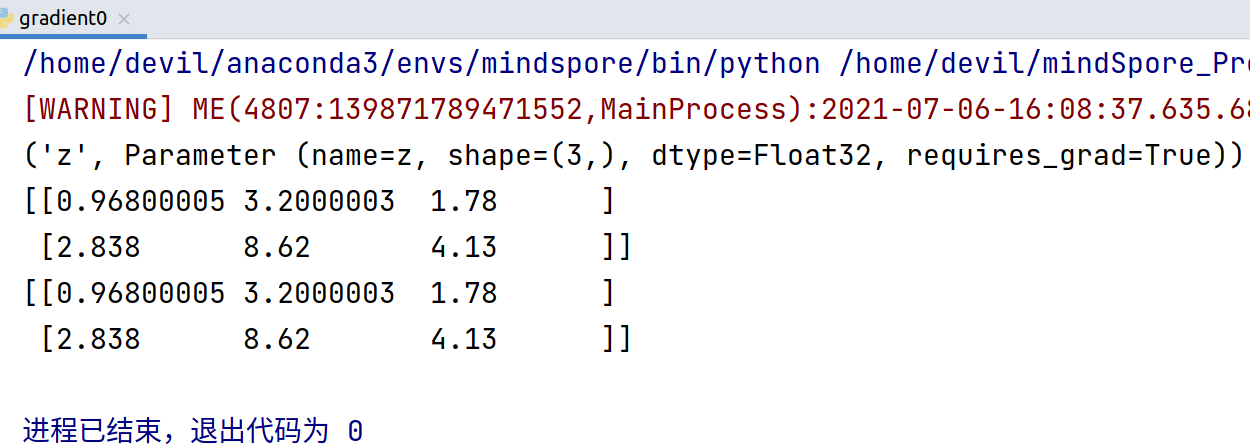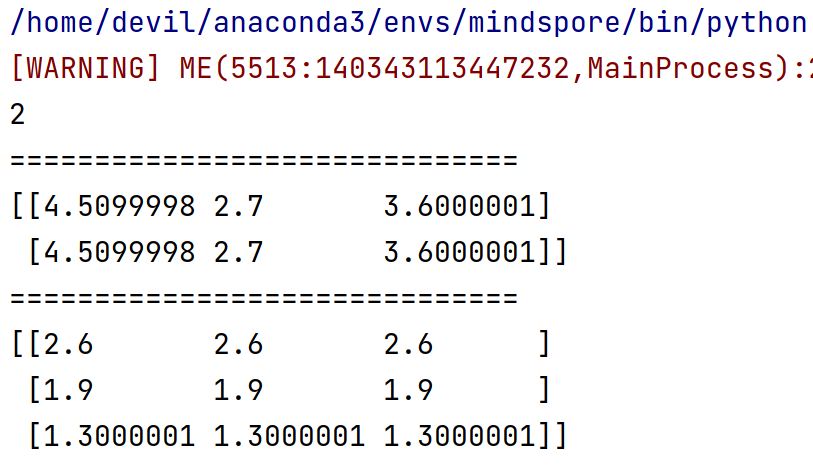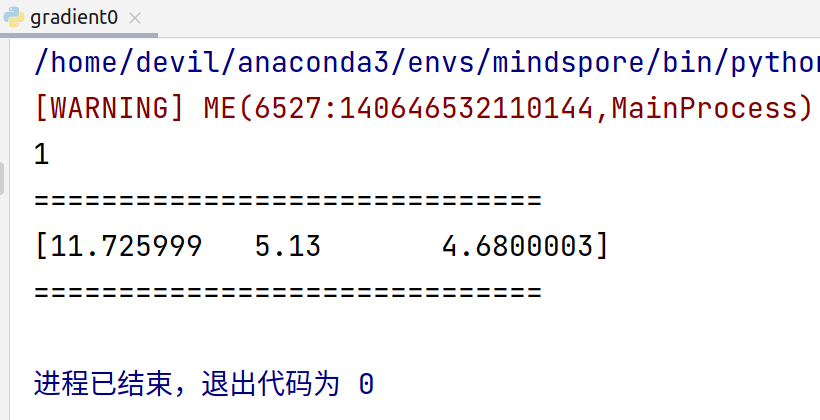MindSpore 自动微分
代码原地址:
https://www.mindspore.cn/tutorial/zh-CN/r1.2/autograd.html
MindSpore计算一阶导数方法 mindspore.ops.GradOperation (get_all=False, get_by_list=False, sens_param=False),其中get_all为False时,只会对第一个输入求导,为True时,会对所有输入求导;
get_by_list为False时,不会对权重求导,为True时,会对权重求导;
sens_param对网络的输出值做缩放以改变最终梯度。
get_all : 决定着是否根据输出对输入进行求导。
get_by_list : 决定着是否对神经网络内的参数权重求导。
sens_param : 对网络的输出进行乘积运算后再求导。(通过对网络的输出值进行缩放后再进行求导)
网络的前向传播:
import numpy as np
import mindspore.nn as nn
import mindspore.ops as ops
from mindspore import Tensor
from mindspore import ParameterTuple, Parameter
from mindspore import dtype as mstype class Net(nn.Cell):
def __init__(self):
super(Net, self).__init__()
self.matmul = ops.MatMul()
self.z = Parameter(Tensor(np.array([1.0, 1.0, 1.0], np.float32)), name='z') def construct(self, x, y):
x = x * self.z
out = self.matmul(x, y)
return out model = Net() for m in model.parameters_and_names():
print(m) x = Tensor([[0.8, 0.6, 0.2], [1.8, 1.3, 1.1]], dtype=mstype.float32)
y = Tensor([[0.11, 3.3, 1.1], [1.1, 0.2, 1.4], [1.1, 2.2, 0.3]], dtype=mstype.float32)
result = model(x, y)
print(result) n_x = np.array([[0.8, 0.6, 0.2], [1.8, 1.3, 1.1]], dtype=np.float32)
n_y = np.array([[0.11, 3.3, 1.1], [1.1, 0.2, 1.4], [1.1, 2.2, 0.3]], dtype=np.float32)
result = model(x, y)
print(result)

=======================================================
反向传播:
import numpy as np
import mindspore.nn as nn
import mindspore.ops as ops
from mindspore import Tensor
from mindspore import ParameterTuple, Parameter
from mindspore import dtype as mstype class Net(nn.Cell):
def __init__(self):
super(Net, self).__init__()
self.matmul = ops.MatMul()
self.z = Parameter(Tensor(np.array([1.0, 1.0, 1.0], np.float32)), name='z') def construct(self, x, y):
x = x * self.z
out = self.matmul(x, y)
return out class GradNetWrtX(nn.Cell):
def __init__(self, net):
super(GradNetWrtX, self).__init__()
self.net = net
self.grad_op = ops.GradOperation() def construct(self, x, y):
gradient_function = self.grad_op(self.net)
return gradient_function(x, y) x = Tensor([[0.8, 0.6, 0.2], [1.8, 1.3, 1.1]], dtype=mstype.float32)
y = Tensor([[0.11, 3.3, 1.1], [1.1, 0.2, 1.4], [1.1, 2.2, 0.3]], dtype=mstype.float32)
output = GradNetWrtX(Net())(x, y)
print(output)
因为, ops.GradOperation(),
mindspore.ops.GradOperation (get_all=False, get_by_list=False, sens_param=False)
get_all=False, 表示只对第一个输入向量求导,也就是对x 求梯度, 结果得到x的梯度:

如果想对所有的输入求梯度, ops.GradOperation(get_all=True)
代码:
import numpy as np
import mindspore.nn as nn
import mindspore.ops as ops
from mindspore import Tensor
from mindspore import ParameterTuple, Parameter
from mindspore import dtype as mstype class Net(nn.Cell):
def __init__(self):
super(Net, self).__init__()
self.matmul = ops.MatMul()
self.z = Parameter(Tensor(np.array([1.0, 1.0, 1.0], np.float32)), name='z') def construct(self, x, y):
x = x * self.z
out = self.matmul(x, y)
return out class GradNetWrtX(nn.Cell):
def __init__(self, net):
super(GradNetWrtX, self).__init__()
self.net = net
self.grad_op = ops.GradOperation(get_all=True) def construct(self, x, y):
gradient_function = self.grad_op(self.net)
return gradient_function(x, y) x = Tensor([[0.8, 0.6, 0.2], [1.8, 1.3, 1.1]], dtype=mstype.float32)
y = Tensor([[0.11, 3.3, 1.1], [1.1, 0.2, 1.4], [1.1, 2.2, 0.3]], dtype=mstype.float32)
output = GradNetWrtX(Net())(x, y)
print(len(output))
print('='*30)
print(output[0])
print('='*30)
print(output[1])
对网络的所有输入求导,即,对 x ,y 求梯度。

对权重求一阶导
对权重求一阶导数其实与前面相比有两个地方要更改:
1. 求导函数要写明对权重求导,即传入参数 get_by_list=True
即,
self.grad_op = ops.GradOperation(get_by_list=True)
2. 具体求导时要传入具体待求导的参数(即,权重):
self.params = ParameterTuple(net.trainable_params())
gradient_function = self.grad_op(self.net, self.params)
细节:


需要知道的一点是如果我们设置了对权重求梯度,则默认不会再对输入求梯度:
代码:
import numpy as np
import mindspore.nn as nn
import mindspore.ops as ops
from mindspore import Tensor
from mindspore import ParameterTuple, Parameter
from mindspore import dtype as mstype class Net(nn.Cell):
def __init__(self):
super(Net, self).__init__()
self.matmul = ops.MatMul()
self.z = Parameter(Tensor(np.array([1.0, 1.0, 1.0], np.float32)), name='z') def construct(self, x, y):
x = x * self.z
out = self.matmul(x, y)
return out class GradNetWrtX(nn.Cell):
def __init__(self, net):
super(GradNetWrtX, self).__init__()
self.net = net
self.params = ParameterTuple(net.trainable_params())
self.grad_op = ops.GradOperation(get_by_list=True) def construct(self, x, y):
gradient_function = self.grad_op(self.net, self.params)
return gradient_function(x, y) model = Net() x = Tensor([[0.8, 0.6, 0.2], [1.8, 1.3, 1.1]], dtype=mstype.float32)
y = Tensor([[0.11, 3.3, 1.1], [1.1, 0.2, 1.4], [1.1, 2.2, 0.3]], dtype=mstype.float32)
output = GradNetWrtX(model)(x, y)
print(len(output))
print('='*30)
print(output[0])
print('='*30)

如果对网络内部权重求梯度同时也想对输入求梯度,只能显示的设置 get_all=True,
即,
self.grad_op = ops.GradOperation(get_all=True, get_by_list=True)
此时输出的梯度为 元组 , tuple(所有输入的梯度, 内部权重梯度)
也就是说这种情况返回的是一个两个元素的元组,元组中第一个元素是所有输入的梯度,第二个是所有内部权重的梯度。
代码:
import numpy as np
import mindspore.nn as nn
import mindspore.ops as ops
from mindspore import Tensor
from mindspore import ParameterTuple, Parameter
from mindspore import dtype as mstype class Net(nn.Cell):
def __init__(self):
super(Net, self).__init__()
self.matmul = ops.MatMul()
self.z = Parameter(Tensor(np.array([1.0, 1.0, 1.0], np.float32)), name='z') def construct(self, x, y):
x = x * self.z
out = self.matmul(x, y)
return out class GradNetWrtX(nn.Cell):
def __init__(self, net):
super(GradNetWrtX, self).__init__()
self.net = net
self.params = ParameterTuple(net.trainable_params())
self.grad_op = ops.GradOperation(get_all=True, get_by_list=True) def construct(self, x, y):
gradient_function = self.grad_op(self.net, self.params)
return gradient_function(x, y) model = Net() x = Tensor([[0.8, 0.6, 0.2], [1.8, 1.3, 1.1]], dtype=mstype.float32)
y = Tensor([[0.11, 3.3, 1.1], [1.1, 0.2, 1.4], [1.1, 2.2, 0.3]], dtype=mstype.float32)
output = GradNetWrtX(model)(x, y)
print(len(output))
print('='*30)
print(output[0])
print('='*30)
print(output[1])
运行结果:
[WARNING] ME(6838:140435163703104,MainProcess):2021-07-06-16:56:49.250.395 [mindspore/_check_version.py:109] Cuda version file version.txt is not found, please confirm that the correct cuda version has been installed, you can refer to the installation guidelines: https://www.mindspore.cn/install
2
==============================
(Tensor(shape=[2, 3], dtype=Float32, value=
[[ 4.50999975e+00, 2.70000005e+00, 3.60000014e+00],
[ 4.50999975e+00, 2.70000005e+00, 3.60000014e+00]]), Tensor(shape=[3, 3], dtype=Float32, value=
[[ 2.59999990e+00, 2.59999990e+00, 2.59999990e+00],
[ 1.89999998e+00, 1.89999998e+00, 1.89999998e+00],
[ 1.30000007e+00, 1.30000007e+00, 1.30000007e+00]]))
==============================
(Tensor(shape=[3], dtype=Float32, value= [ 1.17259989e+01, 5.13000011e+00, 4.68000031e+00]),)
进程已结束,退出代码为 0
MindSpore 自动微分的更多相关文章
- MindSpore:自动微分
MindSpore:自动微分 作为一款「全场景 AI 框架」,MindSpore 是人工智能解决方案的重要组成部分,与 TensorFlow.PyTorch.PaddlePaddle 等流行深度学习框 ...
- MindSpore多元自动微分
技术背景 当前主流的深度学习框架,除了能够便捷高效的搭建机器学习的模型之外,其自动并行和自动微分等功能还为其他领域的科学计算带来了模式的变革.本文我们将探索如何用MindSpore去实现一个多维的自动 ...
- 附录D——自动微分(Autodiff)
本文介绍了五种微分方式,最后两种才是自动微分. 前两种方法求出了原函数对应的导函数,后三种方法只是求出了某一点的导数. 假设原函数是$f(x,y) = x^2y + y +2$,需要求其偏导数$\fr ...
- pytorch学习-AUTOGRAD: AUTOMATIC DIFFERENTIATION自动微分
参考:https://pytorch.org/tutorials/beginner/blitz/autograd_tutorial.html#sphx-glr-beginner-blitz-autog ...
- 自动微分(AD)学习笔记
1.自动微分(AD) 作者:李济深链接:https://www.zhihu.com/question/48356514/answer/125175491来源:知乎著作权归作者所有.商业转载请联系作者获 ...
- <转>如何用C++实现自动微分
作者:李瞬生转摘链接:https://www.zhihu.com/question/48356514/answer/123290631来源:知乎著作权归作者所有. 实现 AD 有两种方式,函数重载与代 ...
- (转)自动微分(Automatic Differentiation)简介——tensorflow核心原理
现代深度学习系统中(比如MXNet, TensorFlow等)都用到了一种技术——自动微分.在此之前,机器学习社区中很少发挥这个利器,一般都是用Backpropagation进行梯度求解,然后进行SG ...
- PyTorch自动微分基本原理
序言:在训练一个神经网络时,梯度的计算是一个关键的步骤,它为神经网络的优化提供了关键数据.但是在面临复杂神经网络的时候导数的计算就成为一个难题,要求人们解出复杂.高维的方程是不现实的.这就是自动微分出 ...
- 【tensorflow2.0】自动微分机制
神经网络通常依赖反向传播求梯度来更新网络参数,求梯度过程通常是一件非常复杂而容易出错的事情. 而深度学习框架可以帮助我们自动地完成这种求梯度运算. Tensorflow一般使用梯度磁带tf.Gradi ...
- PyTorch 自动微分示例
PyTorch 自动微分示例 autograd 包是 PyTorch 中所有神经网络的核心.首先简要地介绍,然后训练第一个神经网络.autograd 软件包为 Tensors 上的所有算子提供自动微分 ...
随机推荐
- Vue学习:21.mixins混入
在Vue中,mixins(混入)是一种用于分发Vue组件中可复用功能的灵活机制.它们允许你抽取组件中的共享功能,如数据.计算属性.方法.生命周期钩子等,并将其作为单独的模块复用到多个组件中.这种方式有 ...
- OOM异常的4种可能分析及常见的OOM异常演示
OOM异常的4种可能分析及常见的OOM异常演示 OOM异常: OutOfMemoryError 1.JAVA堆溢出JAVA堆用于存储对象实例,只要不断的创建对象,并且保证GC Roots到这些对象之间 ...
- Postman 的 Basic Auth 如何通过 Feign 实现
Postman 的 Basic Auth: 分析 根据以上图片分析: Postman 的 Authorization 实际为: header 中添加 Authorization: ******* ** ...
- vue3实现模拟地图上,站点名称按需显示的功能
很久很久没有更新博客了,因为实在是太忙了,每天都有公司的事情忙不完....... 最近在做车辆模拟地图,在实现控制站点名称按需显示时,折腾了好一段时间,特此记录一下.最终界面如下图所示: 站点显示需求 ...
- Log4Net配置详解及输出自定义消息类示例
1.简单使用实例 1.1 添加log4net.dll的引用. 在NuGet程序包中搜索log4net并添加,此次我所用版本为2.0.17.如下图: 1.2 添加配置文件 右键项目,添加新建项, ...
- SQLServer统计采集数据库相关信息
在MS Sql Server中可以能过以下的方法查询出磁盘空间的使用情况及各数据库数据文件及日志文件的大小及使用利用率: 1.查询各个磁盘分区的剩余空间:Exec master.dbo.xp_fixe ...
- Linux 提权-SUID/SGID_1
本文通过 Google 翻译 SUID | SGID Part-1 – Linux Privilege Escalation 这篇文章所产生,本人仅是对机器翻译中部分表达别扭的字词进行了校正及个别注释 ...
- Cannot add or update a child row: a foreign key constraint fails
在使用Django添加用户时出现报错: 1 django.db.utils.IntegrityError: (1452, 'Cannot add or update a child row: a fo ...
- ORACLE 如何判断某字段是否小于0
Oracle 自带的函数 SIGN 表达式的正 (+1).零 (0) 或负 (-1) 号 SQL> SELECT SIGN(-47.3), SIGN(0), SIGN(47.3) FROM du ...
- 文件系统(九):一文看懂yaffs2文件系统原理
liwen01 2024.07.07 前言 yaffs 是专为nand flash 设计的一款文件系统,与jffs 类似,都是属于日志结构文件系统.与jffs 不同的是,yaffs 文件系统利用了na ...
